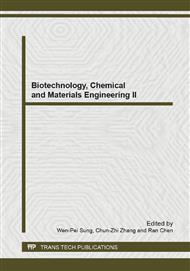p.3
p.7
p.11
p.18
p.22
p.26
p.30
p.35
The Photocatalytic Properties of Br-Doped Titania Nanotube Arrays and its Application in Degradation of Sugar Wastewater
Abstract:
This paper presents a novel approach for preparing titanium dioxide nanotube arrays (TNTs) loaded with highly dispersed Br through an ultrasound aided photochemical route. The content of Br doped on the arrays was controlled by changing the concentration of NaBr and the ultrasound time. The Br doped TiO2 nanotube arrays were characterized by SEM, XRD and UV–Vis spectrum. Doping the bromine did not basically affect the morphology of the surface of the TNTs, but part of the anatase phase transformed into rutile phase, which led to the formation of the mixed crystal and increased the photocatalytic activity. The results showed that Br doping significantly enhanced the photocatalytic degradation rate of titanium dioxide nanotube arrays under UV-light irradiation. The main factors which affected photocatalytic degradation of sugar wastewater were the illumination time and pH. The results showed that the longer the exposure time was, the initial pH of wastewater was more favorable to photocatalytic degradation of the sugar wastewater for the Br-TiO2 nanotube arrays, and compared to undoped TiO2 nanotube arrays Br doped TiO2 nanotube arrays had better photocatalytic properties.
Info:
Periodical:
Pages:
11-17
Citation:
Online since:
January 2013
Authors:
Price:
Сopyright:
© 2013 Trans Tech Publications Ltd. All Rights Reserved
Share:
Citation:


